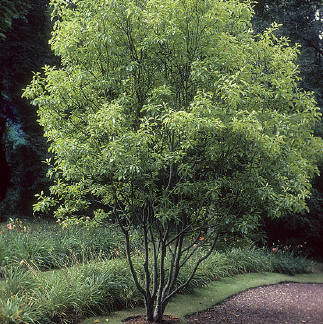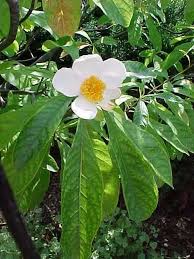Historical Franklinia
Nate Shank
Strawberry Hill Nature Preserve
(11/2013) The Franklinia tree was discovered by botanists John and William Bartram in 1765. It was first found along the Altamaha River in southeast Georgia. On October 1, 1765, after crossing the Altamaha River near Fort Barrington, John and William Bartram came across a group of small trees they had never encountered before. Since the foliage turns
orange, red, and purple in the fall, it is likely that is what caught their attention. After discovering this new species William gathered seeds for their garden in Philadelphia. This garden is now known as Bartram’s Garden, the oldest botanical garden in America. The last confirmed sighting of Franklinia in the wild was in 1790 by Moses Marshall. English nurseryman John Lyon
claimed to have found a few of the plants in 1803, but his report was not certain. The newly discovered plant was likely extinct soon after. Other expeditions to follow turned up empty, and all surviving Franklinias today derive from the Bartram’s Garden.
 Believe it or not Franklinia alatamaha was not the first name given to the plant. Since the Bartrams were unable to classify the plant, it was left with no name for a few years. In 1773, William returned to the location of the wild plant and named it Gordonia
pubescens because it looked like loblolly bay, also known as Gordonia lasianthus. William was later informed that the specimen he had sent to England was a new genus altogether. In 1785 the Bartrams named the new genus Franklinia. The name, Franklinia alatamaha, was given to the tree by John Bartram in honor of his friend Benjamin Franklin. The plant has also been known as
the Franklin tree, the lost Camellia, and the lost Gordonia. Franklinia, Gordonia, and Camellia are members of the tea family Theaceae.
Believe it or not Franklinia alatamaha was not the first name given to the plant. Since the Bartrams were unable to classify the plant, it was left with no name for a few years. In 1773, William returned to the location of the wild plant and named it Gordonia
pubescens because it looked like loblolly bay, also known as Gordonia lasianthus. William was later informed that the specimen he had sent to England was a new genus altogether. In 1785 the Bartrams named the new genus Franklinia. The name, Franklinia alatamaha, was given to the tree by John Bartram in honor of his friend Benjamin Franklin. The plant has also been known as
the Franklin tree, the lost Camellia, and the lost Gordonia. Franklinia, Gordonia, and Camellia are members of the tea family Theaceae.
From the year 1998 to 2000, the John Bartram Association conducted a Franklinia census in 38 states, the District of Columbia, and eight other countries. It was discovered that over 2,000 were reported growing around the world. Most trees were reported in Pennsylvania, North Carolina, and New Jersey. The oldest know Franklinias are growing at Harvard
University’s Arnold Arboretum dating from 1905. The oldest known plant is 21 feet tall and 53 feet wide consisting of eight trunks that are more than five inches in diameter.
The Franklinia is very picky and a challenge to grow. Requirements include well drained acidic soil, wind protection, mulch, and partial shade. It is common for trees in low poorly drained areas to develop root rot. Franklinias also tend to do well in humus enriched soils and can be planted with other acid loving plants such as blueberry. A soil pH of
five to six is best, but most forest soils are accepted. When the roots are not covered by humus, pine needles, or mulch they may heat up and dry out faster. Full sun can stress the tree in long periods of dry heat. Franklinia can also be trouble to transplant, but can more easily be propagated by twig cuttings or from seed. It is adapted well to colder and even subzero
temperatures. It is actually known to do better in northern climates rather than its southern roots. Though it is known to be a difficult plant to propagate and maintain, it is highly valued and desirable due to its beauty, origin, and many enjoy the challenge. Franklinia has also been successfully hybridized with other genera. This diversity may lead to longer lived plants,
better form, disease resistance, and more.
 Franklinia is hardy in plant zones five to eight. It grows 10 to 15 feet tall and can be single-stemmed or multi-stemmed. The height can reach close to 20 feet at full maturity but the tree rarely lives more than 50 years. The three inch flowers bloom in late summer after many other trees are
past blooming often with fall colored foliage. The bark is striped with white on grey. The flowers are white, fragrant, and symmetrical with bright yellow stamens blooming in late summer until frost. With a combination of red and purple foliage and white showy flowers the color display can be phenomenal.
Franklinia is hardy in plant zones five to eight. It grows 10 to 15 feet tall and can be single-stemmed or multi-stemmed. The height can reach close to 20 feet at full maturity but the tree rarely lives more than 50 years. The three inch flowers bloom in late summer after many other trees are
past blooming often with fall colored foliage. The bark is striped with white on grey. The flowers are white, fragrant, and symmetrical with bright yellow stamens blooming in late summer until frost. With a combination of red and purple foliage and white showy flowers the color display can be phenomenal.
It is unlikely that anybody will know why the small Franklinia grove disappeared in the wild, but there have been a few theories. Some believe that the plants declined because of climate change after moving south during the last ice age then not moving north fast enough after the ice sheet receded. Others believe that man destroyed the trees and
habitat. The grove that was found by the Bartrams may not have been genetically diverse enough to fight insects, disease, or other stresses of nature. Another theory is that a forest fire, flood, or other natural disaster wiped out its habitat.
Its cold tolerance and drought sensitivity are just a few of the incompatible characteristics to where it was discovered. The trees flower later than most in the eastern United States, which means that the flowers would be pollinated in September and later. The seed pods do not mature then for another 13 or 15 months. So from the point the flower has
been pollinated to the point the seed is germinating it would have been two years. This behavior is more consistent with northern plants from colder climates. There have been theories that Franklinia was introduced to America in the 1700s when the British were importing plants to England and America from around the world. The theory also considers Asia its origin because of
optimal soil, water, and climate conditions in some high altitudes. Asia is home to some camellia plants that are also in the tea family and also desire long mild days, stronger sunlight later in the year, and cold nights. Other theories have supported the belief that Franklinia is native, and that cotton farming is to blame for the decline and extinction. Botanists have
identified a cotton related pathogen in soil that could be harmful to Franklinia and could have been carried downstream through erosion. If the small grove that was found in Georgia was the last place to evade the pathogen a small natural disaster could have easily caused its absence from the wild. A similar fate has come upon the Wollemi pine in Australia. Less than 100
trees exist and a fungus has been unintentionally introduced that can be potentially deadly. The Wollemi pine could have a similar fate as the Franklinia if we didn’t have modern science.
About 24 years ago while clearing invasive brush at Strawberry Hill Nature Preserve a small tree was found and identified as a Franklinia. Since then it has been singled out and can still be seen beside our Nature Center to this day. For more interesting information about Strawberry Hill Nature Preserve visit www.StrawberryHill.org, call 717-642-5840,
or email info@strawberryhill.org.